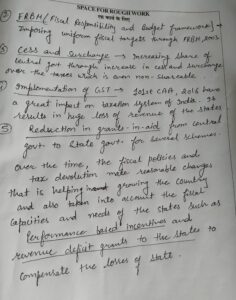Does the Indian federalism make the relationship of governments more complex? Elaborate your opinions.
Model Answer Necessity of Asymmetry in India's Federalism India's federalism is inherently asymmetric, characterized by unequal power distribution and distinct political, administrative, and fiscal relations between the center and states. While asymmetric federalism has been a fundamental feature ofRead more
Model Answer
Necessity of Asymmetry in India’s Federalism
India’s federalism is inherently asymmetric, characterized by unequal power distribution and distinct political, administrative, and fiscal relations between the center and states. While asymmetric federalism has been a fundamental feature of India’s political structure, its necessity remains a subject of debate.
1. Historical Context and Integration
Asymmetric federalism was crucial for India’s integration after independence. The country emerged from British rule, with regions directly under British governance and 216 princely states, each with varying degrees of autonomy. Special provisions, like Article 370 for Jammu and Kashmir, were designed to integrate these regions into the Union. This was essential in ensuring national unity and preventing fragmentation (Source: Constitution of India, Article 370).
2. Ensuring National Security and Unity
Asymmetric arrangements were also key to ensuring national security and political stability. For example, the Sixth Schedule provided autonomy to tribal areas in the northeastern states, transforming erstwhile insurgents into important stakeholders within the Indian polity. This helped address regional security concerns while maintaining unity in a diverse nation (Source: Constitution of India, Sixth Schedule).
3. Recognition of Diversity
India’s diversity, in terms of languages, cultures, and regional aspirations, makes asymmetric federalism necessary to ensure that local contexts are considered in governance. Special provisions under Article 371 grant states like Nagaland and Andhra Pradesh specific privileges based on their distinct needs, ensuring policies align with local aspirations (Source: Constitution of India, Article 371).
4. Economic and Administrative Factors
India’s diverse states face varying economic challenges. Larger states with bigger populations need more fiscal resources for public service delivery. This makes asymmetric fiscal federalism essential, as mechanisms like the Finance Commission help allocate resources more equitably (Source: Finance Commission Reports).
Conclusion
Despite criticisms of resource misallocation and regional disparities, asymmetric federalism is essential for India to accommodate its diverse needs, ensure national unity, and provide equitable governance. It remains a necessary feature to manage the country’s complexity, particularly in promoting cooperative federalism where all groups can have a voice.
See less


Complexities of Indian Federalism and Its Impact on Government Relationships 1. Introduction: Indian federalism, characterized by a division of powers between the Central Government and State Governments, does indeed introduce complexities in the relationship between different levels of government.Read more
Complexities of Indian Federalism and Its Impact on Government Relationships
1. Introduction:
Indian federalism, characterized by a division of powers between the Central Government and State Governments, does indeed introduce complexities in the relationship between different levels of government. This structure is designed to balance autonomy with unity, but it can also create challenges in governance and coordination.
2. Structural Complexities:
Division of Powers: The Constitution of India delineates powers between the Union and the States through three lists: the Union List, the State List, and the Concurrent List. This division can lead to disputes over jurisdiction and authority. For instance, issues related to environmental regulation often see conflicts between state and central policies.
Central and State Authority: The Central Government holds significant powers in areas like defense and foreign affairs, while states have authority over subjects such as police and public health. However, the Residuary Powers lie with the Centre, which can lead to disputes over subjects not explicitly listed in the Constitution.
3. Practical Challenges and Recent Examples:
Policy Conflicts: Conflicts can arise when state and central policies diverge. For instance, the Goods and Services Tax (GST), implemented in 2017, required complex coordination between the Centre and States. While GST aimed to streamline tax administration, states have expressed concerns over revenue-sharing and compensation.
Disputes and Litigation: Disputes between the Centre and states often lead to litigation. For example, the Kaveri River Water Dispute involves multiple states and the Centre, illustrating how water resources management can become a contentious issue under federalism.
Coordination Issues: In times of crisis, such as the COVID-19 pandemic, coordination between the Centre and States has been critical but challenging. States had to manage their own responses while adhering to central guidelines, leading to varying degrees of effectiveness and occasional conflicts over policy implementation.
4. Recent Developments and Measures:
Federalism and Finance Commission: The Finance Commission plays a crucial role in addressing fiscal federalism issues by recommending how resources should be distributed between the Centre and States. The 15th Finance Commission has focused on equitable resource distribution, particularly in the context of the COVID-19 pandemic.
Empowerment of States: Recent reforms aim to empower states and address some of the complexities. For example, the National Education Policy (NEP) 2020 emphasizes state autonomy in education while providing a framework for national standards, seeking to balance federal and state interests.
Inter-State Councils: Bodies like the Inter-State Council facilitate dialogue and cooperation between the Centre and States. The council helps address inter-state issues and fosters a collaborative approach to federal governance.
5. Conclusion:
Indian federalism, with its division of powers and responsibilities, undeniably adds complexity to the relationships between different levels of government. While it aims to balance regional autonomy with national unity, it also necessitates effective mechanisms for coordination, conflict resolution, and cooperation. Addressing these complexities requires ongoing dialogue, legal frameworks, and institutional mechanisms to ensure a harmonious federal structure and effective governance.
See less